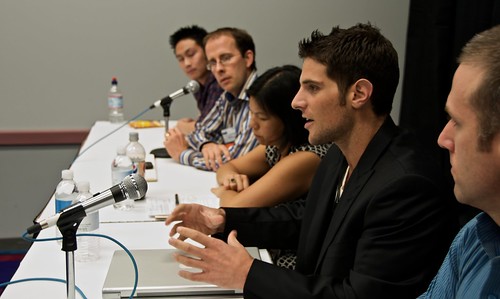The post 5 advocacy lessons from the Kony 2012 video appeared first on Socialbrite.
]]>Issues of storytelling, transparency & disclosure come to fore
 The big social media story of the year so far has been Invisible Children’s 30-minute film on Joseph Kony. I mean, you just couldn’t get away from it last week — 75 million views on YouTube and counting.
The big social media story of the year so far has been Invisible Children’s 30-minute film on Joseph Kony. I mean, you just couldn’t get away from it last week — 75 million views on YouTube and counting.
I was fascinated, not so much by the video, which I agree was beautifully produced, but by the amount of conversation it generated. So I talked to a few of my colleagues in the nonprofit world, all powerhouse professionals, to get their take on the video and the cultural hubbub that ensued.
And while much has already been written about the campaign, including this terrific Forbes piece on social media lessons, here are a few things nonprofit organizations should keep in mind when using digital media to further their causes:
You must let the truth get in the way of a good story
 1One of the primary criticisms is that the Kony 2012 video doesn’t accurately represent the current state of affairs in Uganda and the Lord’s Resistance Army, not to mention the fact that warlord Joseph Kony hasn’t been in that country in a while. Invisible Children said that in order for the story to resonate, they had to simplify it, and basically admitted via the statement on their site that they left out a lot of detail:
1One of the primary criticisms is that the Kony 2012 video doesn’t accurately represent the current state of affairs in Uganda and the Lord’s Resistance Army, not to mention the fact that warlord Joseph Kony hasn’t been in that country in a while. Invisible Children said that in order for the story to resonate, they had to simplify it, and basically admitted via the statement on their site that they left out a lot of detail:
“In our quest to garner wide public support of nuanced policy, Invisible Children has sought to explain the conflict in an easily understandable format, focusing on the core attributes of LRA leadership that infringe upon the most basic of human rights. In a 30-minute film, however, many nuances of the 26-year conflict are admittedly lost or overlooked.”
Yes, the story is complicated. But with the expert talent at their disposal, I have a hard time believing Invisible Children couldn’t have given a sense of history by date-stamping the different interviews and so on.
Beth Kanter agreed, saying, “I believe nonprofits, in a day of social media connectedness, really have to understand transparency and that they can’t get away with not being transparent.” Beth elaborated further on this in a recent post, reiterating that “for responsible social change, you need transparency.”
How much storytelling is too much storytelling?
2Kami Watson Huyse raised an interesting point: “It was clear to me that this video was a storytelling exercise, and stories by definition are personal and take a particular point of view. I was more concerned with his use of his own son’s reaction as part of the story.
“The truth is a matter of interpretation. I think that this video was designed to get people to act, not to be a realistic documentary.”
While I’m not a parent, I would imagine this would resonate with many of you who are. We’ve seen time and time again that good stories are those are easy to understand and that pull on your heartstrings. But do you really have to bring your kids into it?
From Beth on storytelling: “Successful messaging is compelling, visual, emotional and simple. Some highly effective online activists told me that one of their secrets is that their messaging is at sixth-grade level because that makes it clear and simple to understand. That’s a good thing to do.”
Kony 2012 did that in spades. But at what price? At what point does the story take over the agenda — or become the agenda? It goes back to being transparent – which pretty much everyone I asked agreed was key. Nancy Schwartz summed it up perfectly: “The end doesn’t justify the means.”
It’s tough to say no to kids
 3I first heard about the video from my Johns Hopkins students. Granted, they’re not kids, but they’re exactly the demographic of young activist and activist-oriented people that the film was trying to reach. Beth said she first heard about it from her 12-year-old son. JD Lasica, my Socialbrite colleague, first heard about it from his 12-year-old son. (By the way, JD interviewed one of the founders of Invisible Children for Socialbrite in 2009.)
3I first heard about the video from my Johns Hopkins students. Granted, they’re not kids, but they’re exactly the demographic of young activist and activist-oriented people that the film was trying to reach. Beth said she first heard about it from her 12-year-old son. JD Lasica, my Socialbrite colleague, first heard about it from his 12-year-old son. (By the way, JD interviewed one of the founders of Invisible Children for Socialbrite in 2009.)
My guess is that versions of this scenario played out in countless homes across America last week. (How about yours?)
What happens when your kids, or young people you are responsible for, announce a new fact? You go look it up. What happens when they tell you they’ve just learned about ____ cause and are going to support it? You go look it up — because you want to support them, you’re proud of their developing a social conscience, and you don’t want to let them down. Right?
And if they ask you to support it along with them, it becomes really, really hard to say “no,” especially if they are convinced that a particular cause is going to hunt down a “bad guy.” Because if you refuse, doesn’t that make you a bad guy by association?
If you’re going to try and generate social change through young people, you have a responsibility to them to make sure they understand exactly what they’re getting into. Yes, this goes back to telling the truth. Because if you don’t, it could backfire.
Be prepared for everything to be scrutinized
4Invisible Children started out trying to raise awareness — in their own words, to “make Joseph Kony famous.” But now everything about the nonprofit is being scrutinized, from its financials to its motives. To its credit, Invisible Children has posted several years’ worth of 990s on its site and clearly reiterated, time and time again, the approximate breakdown of expenses.
Did it anticipate having to do this? Probably. But it probably didn’t anticipate the amount of criticism that would be leveled at it. In fact, yesterday CNN reported that director Jason “Russell said he had been a little surprised by some of the criticism. ‘I didn’t know there was that much tension,’ he said.”
Personally, I find this a little naïve. If you’re dealing with an issue that is emotional at its core, it’s going to create, or reveal, tension. The nonprofit world, while doing a lot of good, has its share of competition and politics. After all, there is only so much attention the rest of us have to direct toward causes, and there is only so much our pocketbooks can take. Of course there’s going to be tension.
So even if you don’t think your mission will generate controversy, prepare as if it will. Be prepared for everything – everything – to be scrutinized. And though your original message might be co-opted or broken down in ways you hadn’t anticipated, at least you will remain part of the conversation.
Be clear on what you classify as direct services
5One of the major criticisms that’s been made is that only about a third of the money Invisible Children raises goes to direct services, with the other approximate two-thirds going to film production and marketing. Russell has been unapologetic about this, basically saying that this is how they function, and that raising awareness — through videos, marketing, social media, etc. — is critical to their cause.
This is a conundrum that a lot of nonprofits have to face. Because without marketing, you can’t raise awareness. Without awareness, you can’t get donations. Without donations, you can’t fund your programs.
And since the percentage allocated to programs is one of factors in ratings issued by nonprofit evaluation sites like Charity Navigator — note it gives Invisible Children only two stars out of four for accountability and transparency — you have to be really careful that the public is given as accurate a picture as possible about not just how you raise money, but how you spend it and what exactly classifies as a “program.”
Should rating sites change the way they evaluate nonprofits, particularly to account for the increased importance of marketing? As Kami pointed out, this has been an ongoing debate for a while.
But one way that Invisible Children could do this is, as Nancy pointed out, to “consider marketing as the program. If raising awareness is the goal, this stuff is the program!” (If you look at Invisible Children’s description of its programs, they all seem to be direct service-based.)
What do you think about the Invisible Children video and ensuing firestorm? Do you have other lessons for nonprofit organizations, or do you think I got any of the above wrong? And many thanks to Beth, Nancy, JD and Kami for helping me put this post together!
Related
• The story behind Invisible Children (Socialbrite)
• KONY, Networked Nonprofits, and Transparency (bethkanter.org)
• The best tools for advocacy campaigns (Socialbrite)
• How to effectively use calls to action in nonprofit videos (Socialbrite)
• Writeups on advocacy campaigns (Socialbrite)
 This work is licensed under a Creative Commons Attribution-NonCommercial 3.0 Unported.
This work is licensed under a Creative Commons Attribution-NonCommercial 3.0 Unported.
The post 5 advocacy lessons from the Kony 2012 video appeared first on Socialbrite.
]]>The post The story behind Invisible Children appeared first on Socialbrite.
]]>The story behind Invisible Children from JD Lasica on Vimeo.
 Laren Poole came about his cause, Invisible Children, completely by accident. He and two friends were documenting the refugee situation in Sudan six years ago when they crossed the border into northern Uganda and came upon a completely different conflict they didn’t know about: kids who were being abducted by the thousands and forced to fight in the bush as child soldiers.
Laren Poole came about his cause, Invisible Children, completely by accident. He and two friends were documenting the refugee situation in Sudan six years ago when they crossed the border into northern Uganda and came upon a completely different conflict they didn’t know about: kids who were being abducted by the thousands and forced to fight in the bush as child soldiers.
The makeshift filmmaking crew stayed for two months and released the documentary Invisible Children. From there, the movie evolved into a global movement and nonprofit organization that is using the transformative power of story to change lives.
In this short video interview, conducted at Social Capital Markets 2009 in San Francisco, Poole talks about the organization’s effort to get governments around the world to stop Joseph Kony, leader of the rebel movement in Uganda and “the world’s worst criminal,” in Poole’s words, from forcing thousands of children into armed conflict.
Toward that end, Invisible Children has held a series of large rallies nationwide, organized a march on Washington, DC, and raised funds to build 10 high schools in Uganda. Throughout it all, they’ve used the tools of the Internet and social media to rally attention to the cause. “We’ve unleashed this young generation on this problem and documented what they’ve done about it,” he says.
One highlight of the awareness campaign came this past spring when Invisible Children staged a weeklong series of rescue events in 100 cities around the world. The crowds of mostly young people included 80,000 people in Chicago who stayed until, at the end, 500 hard-core supporters managed to earn Oprah Winfrey’s attention by camping outside her office building. “We held Oprah hostage,” Poole says, tongue in cheek, until she finally put them on her show on May 1.
Watch, embed or download the video interview on Vimeo
What motivates young supporters to get involved? “We break it down into a menu of things that they can do to make real change happen,” Poole says. We show them the results of the impact their contributions make, “and we add a bit of fun to it.”
You can join the Invisible Children cause on Facebook Causes — three quarters of a million people have done so.
One word about the video: I need to learn how to use the white balance settings on my Canon HV20 when shooting outdoors, since I don’t have powerful lighting gear to make up for the harsh shadows.
Related
• Embrace Disruption! Coverage of Laren Poole during his appearance at SoCap09 (earthsite)
• PETITION: Get Obama To Commit To Arrest Warlord Joseph Kony (huffingtonpost.com)
 This work is licensed under a Creative Commons Attribution 3.0 Unported.
This work is licensed under a Creative Commons Attribution 3.0 Unported.
The post The story behind Invisible Children appeared first on Socialbrite.
]]>The post 8 tips for raising funds online appeared first on Socialbrite.
]]>
At BlogWorld Expo, tools and strategies for nonprofits
 The first Causes/Activism track at the just-ended Blogworld Expo in Las Vegas drew some 1,500 participants — a promising showing by the nonprofit community. I moderated the Tools for Nonprofit Organizations panel, with panelists Judy Chang of Paypal, Justin Perkins of Care2, David Levy of SocialVibe, James Sutandyo of Causecast and consultant Scott Henderson.
The first Causes/Activism track at the just-ended Blogworld Expo in Las Vegas drew some 1,500 participants — a promising showing by the nonprofit community. I moderated the Tools for Nonprofit Organizations panel, with panelists Judy Chang of Paypal, Justin Perkins of Care2, David Levy of SocialVibe, James Sutandyo of Causecast and consultant Scott Henderson.
Here’s my Flickr photo set of BlogWorld Expo, about 60 photos in all. I also put together this Delicious tag — delicious.com/bwe09 — to aggregate many of the the services, tools and platforms that nonprofits and social change organizations can use to raise funds to advance their missions online.
About 100 people, chiefly from nonprofits small and large, attended our panel and you can follow what they tweeted about the session at #tools4npo
The panelists collectively came up with these recommendations:
8 tips for raising funds online
1. Make it a specific project, not for the overarching nonprofit or a general fund
2. Tell a compelling story with a strong human-interest angle
3. Create a feedback loop from the recipients to the donors to form an emotional bond
4. Have a hard stop — set a date to donate by
5. Pool your efforts by collaborating with reputable like-minded partners (including trading space in partners’ email newsletters)
6. Don’t pussyfoot around — have a clear and specific “ask” or call to action
7. Consider using contests or drawings to draw in more people
8. Your destination website doesn’t matter as much as it once did, so spread your efforts across several social networks
Successful social media efforts
 Panelists pointed to several initiatives that nonprofits could learn from:
Panelists pointed to several initiatives that nonprofits could learn from:
• charity: water’s September birthday campaign. “They make it about you,” said Henderson.
• LiveStrong, the Lance Armstrong Foundation, has a strong community outreach program.
• America’s Giving Challenge, allowing users to vote for daily and overall causes they want to support.
• The Nature Conservancy’s Adopt an Acre of Rainforest program — for every 10 gifts you send, you’ll save 1 square foot of Rainforest.
• Invisible Children’s Visible Children Scholarship Program.
Kudos to eBay for underwriting the Causes/Activism track, and to Cause Media Group for organizing the sessions — not an easy undertaking.
 This work is licensed under a Creative Commons Attribution 3.0 Unported.
This work is licensed under a Creative Commons Attribution 3.0 Unported.
The post 8 tips for raising funds online appeared first on Socialbrite.
]]>![Reblog this post [with Zemanta]](http://img.zemanta.com/reblog_e.png?x-id=0623534f-fb84-4bf5-9f07-92e1edbc7bb9)